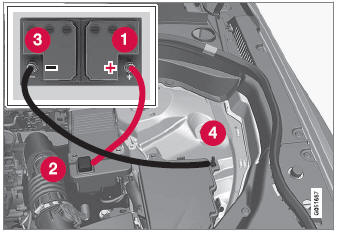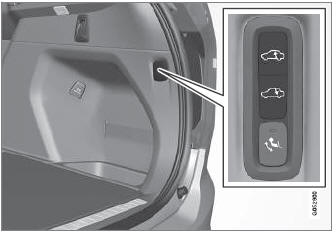Volvo XC90: Starting and driving / Jump starting using another battery
If the start battery is discharged, current from another battery can be used to start the vehicle.

Jumper cable connecting points. Engine compartment appearance may vary depending on vehicle model and equipment level.
To avoid short circuits or other damage, the following steps are recommended when jump starting the battery using another battery:
- Put the ignition in mode 0.
- Make sure the auxiliary battery (the battery used to jump start the discharged battery) has a voltage of 12 volts.
- If the auxiliary battery is in another vehicle, turn off that vehicle's engine and make sure that the vehicles are not touching each other.
- Clamp the red jumper cable onto the auxiliary battery's positive (+) terminal
(1).
CAUTION
Connect the jump cable carefully to prevent short circuits with other components in the engine compartment.
- Fold back the cover over your vehicle's positive (+) jump start terminal (2).
- Clamp the other end of the red jumper cable to your vehicle's positive (+) jump start terminal (2).
- Clamp the black jumper cable onto the auxiliary battery's negative (-) terminal (3).
- Clamp the other end of the black jumper cable to your vehicle's negative (-) ground point (4).
- Make sure the jumper cables are securely attached to help prevent sparks while jump starting.
- Start the engine of the assisting vehicle and let it run for a few minutes at a higher idling speed than normal, about 1500 rpm.
- Start the engine of the vehicle with the dead battery.
CAUTION
Do not touch the connections between the cable and the vehicle during the start attempt. Risk of sparking.
- Remove the jumper cables in the reverse order ‒ first the black cables and
then the red cables.
Make sure that none of the clamps of the black jumper cables come into contact with either vehicle's positive (+) jump start terminals or either of the red jumper cable's connected clamps.
WARNING
High voltage may be dangerous if handled incorrectly. Do not touch anything on batteries that is not clearly described in this Owner's Manual.
- Never use a 48 V support battery to jump start the vehicle.
- External electrical equipment may not under any circumstance be connected to the 48 V battery.
- Only a workshop may replace or perform service on the 48 V battery – an authorized Volvo workshop is recommended.
WARNING
PROPOSITION 65 WARNING! Battery posts, terminals, and related accessories contain lead and lead compounds, chemicals known to the state of California to cause cancer and reproductive harm. Wash hands after handling.
WARNING
- Batteries generate hydrogen gas, which is flammable and explosive.
- Do not connect the jumper cable to any part of the fuel system or to any moving parts. Avoid touching hot manifolds.
- Battery fluid contains sulfuric acid. Do not allow battery fluid to contact eyes, skin, fabrics or painted surfaces.
- If contact occurs, flush the affected area immediately with water. Obtain medical help immediately if eyes are affected.
- Never expose the battery to open flame or electric spark. Do not smoke near the battery. Failure to follow the instructions for jump starting can lead to injury.
NOTE
If the starter battery has been discharged to the extent that the vehicle does not have normal electrical functions and the engine must then be jump-started with an external battery or a battery charger, the Start/Stop function may remain activated. If the Start/ Stop function shortly thereafter auto-stops the engine, there is a huge risk that autostart of the engine will fail due to insufficient battery capacity since the battery had not had time to recharge.
If the vehicle has been jump-started or if there has not been enough time for the battery to be charged with a battery charger, the Start/Stop function should be temporarily deactivated until the battery has been recharged by the vehicle. At an ambient temperature of about +15°C (about 60°F), the battery must be charged by the vehicle for at least one hour. At lower ambient temperatures, the charging time can increase to 3-4 hours. It is advisable to charge the battery with an external battery charger.
 Battery drain
Battery drain
The electrical functions in the vehicle drain the battery to varying degrees.
Avoid using ignition mode II when the engine is switched off. Use ignition mode
I instead, as this uses less electrical current...
 Retractable hitch
Retractable hitch
(Option/accessory.)
The retractable hitch is designed to be used to tow a trailer or mount a bicycle
holder. The hitch can be easily retracted or extended as needed...
Other information:
Volvo XC90 2015-2025 Owners Manual: Park Assist Pilot messages
(Option/accessory. Messages for Park Assist Pilot (PAP1) may be displayed in the instrument panel and/or the center display. Several examples are provided below. A An authorized Volvo workshop is recommended. A text message can be erased by briefly pressing the button in the center of the rightside steering wheel keypad...
Volvo XC90 2015-2025 Owners Manual: SiriusXM Travel Link® - Notifications
(Option/accessory.) This SiriusXM Travel Link service provides notifications of potential weather problems or other emergency situations in the vicinity of the vehicle. From the SiriusXM Travel Link home screen, to show notifications: Tap the Alerts button to display this screen...

